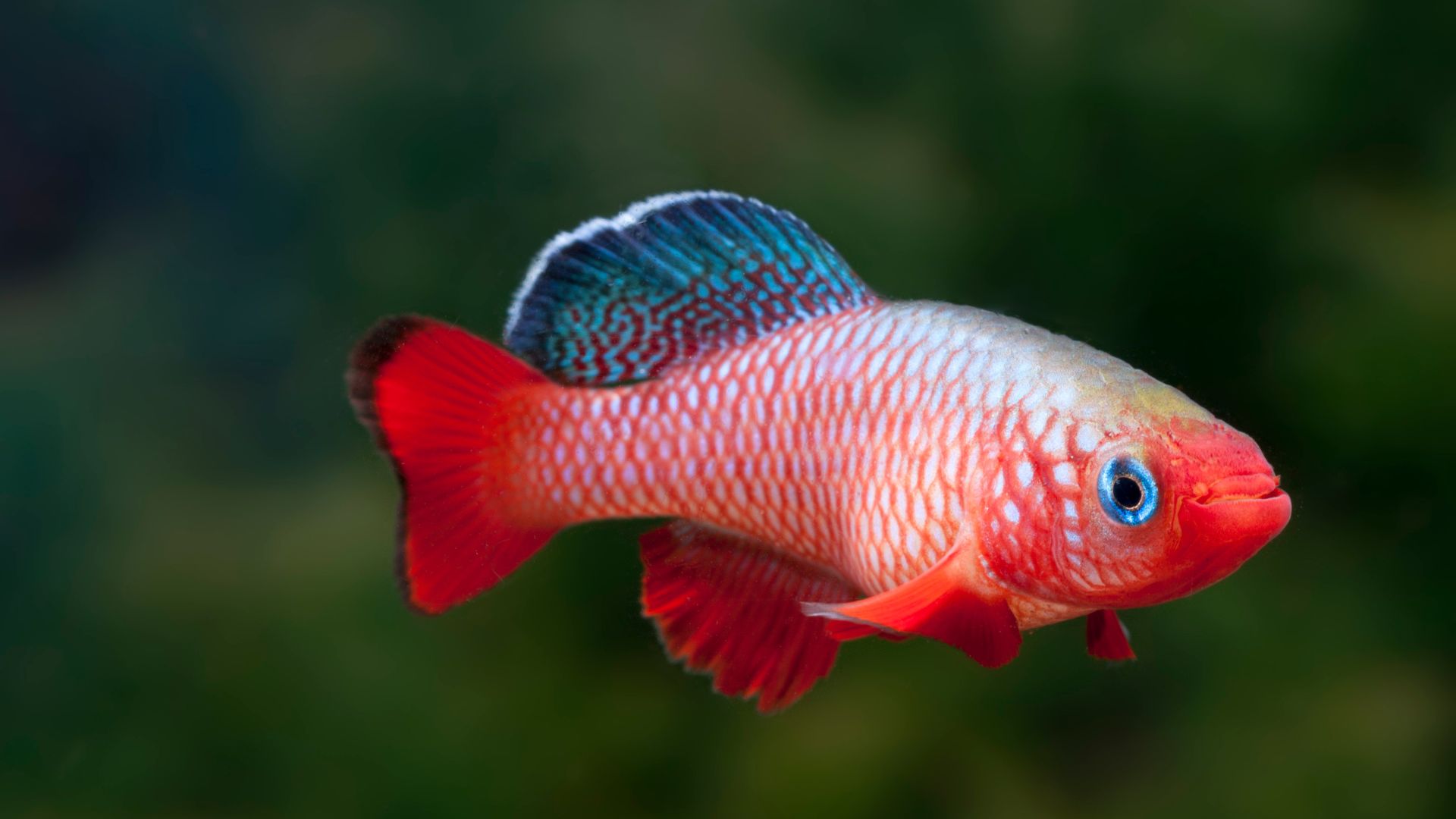
Killifish
Scientific name: Varies by species; common genera include Aphyosemion, Fundulopanchax, Nothobranchius, and Aplocheilus
The Killifish is a diverse group of small, colorful freshwater fish found in various habitats worldwide, from temporary pools to streams and swamps.
Known for their vibrant colors and unique life cycles, Killifish are a favorite among aquarium enthusiasts who appreciate their beauty and interesting breeding behaviors. They come in a wide array of colors and patterns, making them a visually striking addition to any aquarium.
IUCN Red List of Threatened Species : Varies by species; some are listed as Least Concern, while others are Vulnerable or Endangered due to habitat loss and environmental changes
Killifish thrive in tanks that replicate their natural environments, which often include soft, acidic water with plenty of vegetation. They prefer well-planted aquariums with hiding spots and subdued lighting. Many species are jumpers, so a tight-fitting lid is essential to prevent escapes. While they can be kept in community tanks with compatible species, they often do best in species-specific setups.
They are carnivorous and prefer a diet rich in live foods such as brine shrimp, daphnia, mosquito larvae, and bloodworms. Some may accept high-quality flake or frozen foods, but live foods help maintain their health and vibrant colors.

Navite Location
Africa, North and South America, Southern Europe, and parts of Asia; habitats include temporary pools, streams, marshes, and swamps
Varieties
Golden Wonder / Clown / Blue Gularis / Gardneri / Lyretail / Red-Striped
Suggested Tank Mates
Small, peaceful tetras / Corydoras Catfish / Otocinclus Catfish / Shrimp (with caution) / Other small, non-aggressive fish
Tank Mates to Avoid
Large or aggressive fish / Fin-nippers like Tiger Barbs / Fast-swimming species that may outcompete them for food / Bettas and Gouramis (may cause territorial disputes)
Diet
Live foods (brine shrimp, daphnia, mosquito larvae, bloodworms) / Frozen foods (bloodworms, tubifex worms) / High-quality flake or micro-pellets (accepted by some species) / Insect-based foods
Breeding
Killifish have fascinating breeding behaviors that vary by species. Annual Killifish, found in temporary pools, lay drought-resistant eggs in the substrate, which can survive dry periods and hatch when water returns. Non-annual species lay eggs on plants or spawning mops. Breeding often requires simulating natural conditions, such as changing water levels or temperatures. They do not exhibit parental care, and eggs or fry should be separated to prevent predation by adults.
Lifespan
Annual species – 1 year or less / Non-annual species – Up to 2-5 years with proper care
Size
Small species – 2.5–5 cm (1–2 inches) / Larger species – Up to 12 cm (4.5 inches)
Minimum Tank Size
Small species – 10 gallons (38 liters) / Larger species – 20 gallons (76 liters) or more
Optimum Tank Temperature
Tropical species – 22°C to 26°C (72°F to 79°F) / Temperate species – 18°C to 22°C (64°F to 72°F)
Ideal pH Level
Most species – 6.0 to 7.5 / Some species may prefer slightly more acidic or alkaline conditions
Water Hardness
5 – 15 dGH
Common Health Issues
Ich (White Spot Disease) / Velvet Disease / Fungal Infections / Parasitic Infestations / Stress-related illnesses due to poor water quality or inappropriate tank conditions
Interesting facts
Adaptation to Extreme Environments
Some Killifish inhabit ephemeral pools that dry up seasonally. Their eggs can enter a diapause state, surviving without water for months until rains return.
Diverse Species
With over 1,200 species, Killifish display an incredible variety of colors, patterns, and sizes, making them a diverse group within the aquarium hobby.
Sexual Dimorphism
Males are typically more brightly colored and have longer fins than females, especially during breeding seasons.
Social Hierarchy
Killifish are known to be excellent jumpers, a trait they use in the wild to escape predators or move between water bodies. This makes a secure aquarium lid essential.
Scientific Research
Certain species, like the Turquoise Killifish (Nothobranchius furzeri), are studied extensively in aging research due to their short lifespans and rapid development.
Killifish FAQ’s
Can Killifish Be Kept in Community Tanks?
While Killifish can sometimes be kept in community tanks, it depends on the species and the temperament of both the Killifish and potential tank mates.
Some Killifish are shy and may be outcompeted for food by more aggressive or faster-moving fish. Others may display territorial behavior, especially males during breeding seasons. If you choose to keep Killifish in a community tank, select peaceful, similarly sized species that occupy different areas of the tank and ensure there are plenty of hiding spots.
Do Killifish Require Special Care?
Killifish have specific care requirements that vary by species.
Many prefer soft, acidic water and subdued lighting. They often thrive in well-planted tanks with plenty of hiding places. Live foods are important for their diet, and water quality must be maintained diligently.
For breeding, some species require simulation of natural environmental changes, such as altering water levels or temperatures. Researching the specific needs of the Killifish species you intend to keep is essential for their health and well-being.
How Do You Breed Killifish?
Breeding Killifish can be a rewarding experience due to their unique reproductive strategies.
Annual Killifish species lay eggs in the substrate, which can be collected and stored in moist peat moss to simulate a dry season. After a resting period, reintroducing the eggs to water triggers hatching.
Non-annual species often lay eggs on spawning mops or plants. Providing appropriate breeding conditions, separating eggs or fry from adults, and feeding the fry with infusoria or newly hatched brine shrimp are key steps in successful breeding.
Are Killifish Good for Beginners?
Some Killifish species are suitable for beginners who are willing to meet their specific care requirements, such as the Golden Wonder Killifish. However, many species are better suited for intermediate to experienced aquarists due to their specialized needs regarding water conditions, diet, and breeding.
Beginners interested in Killifish should start with hardy species and thoroughly research their care.
Why Are Killifish Called “Killifish”?
The name “Killifish” is derived from the Dutch word “kilde” or Middle Dutch “kille,” meaning small creek or puddle. This refers to the natural habitats of many Killifish species, which are often found in small bodies of water like streams, ponds, and temporary pools.
